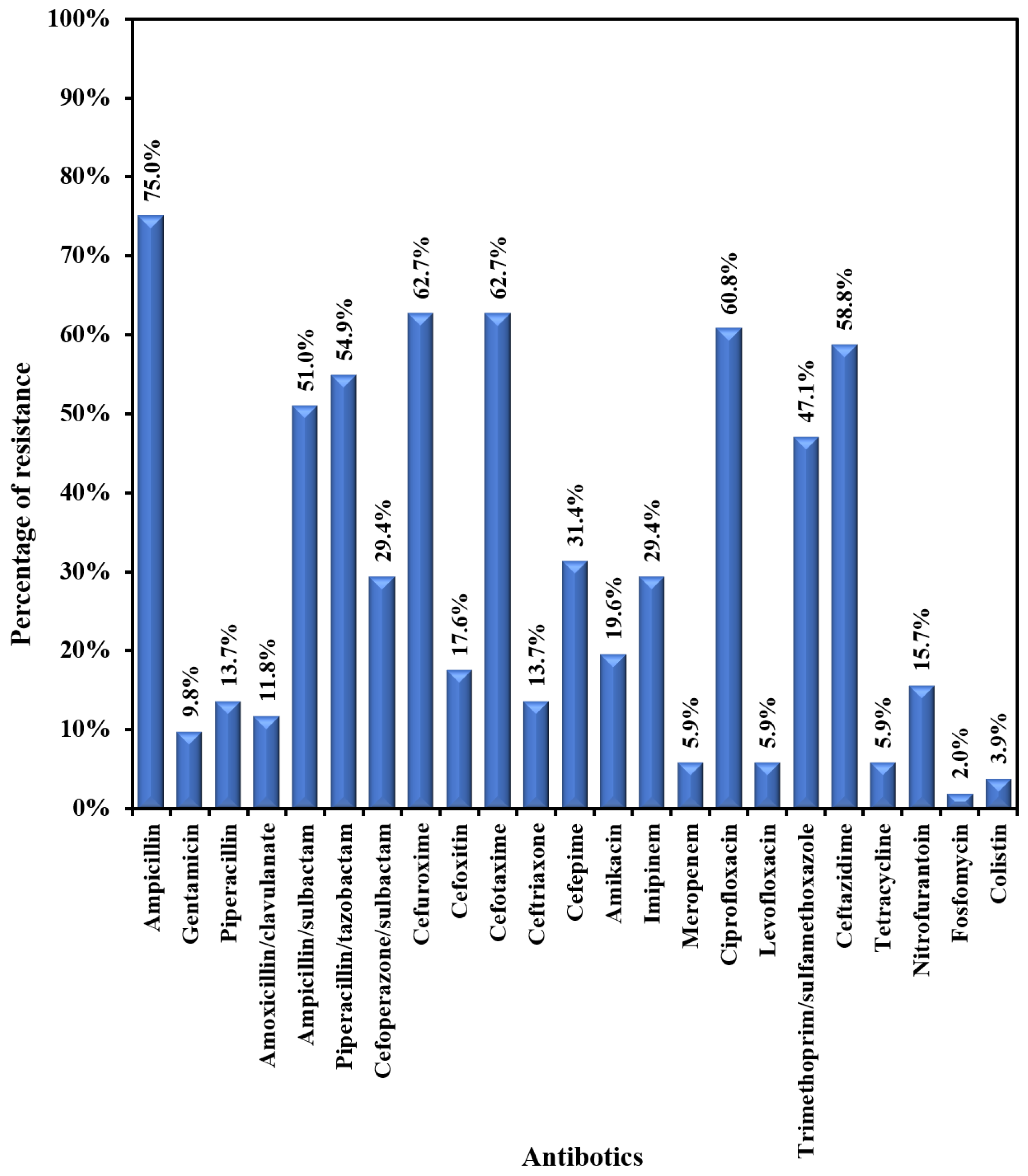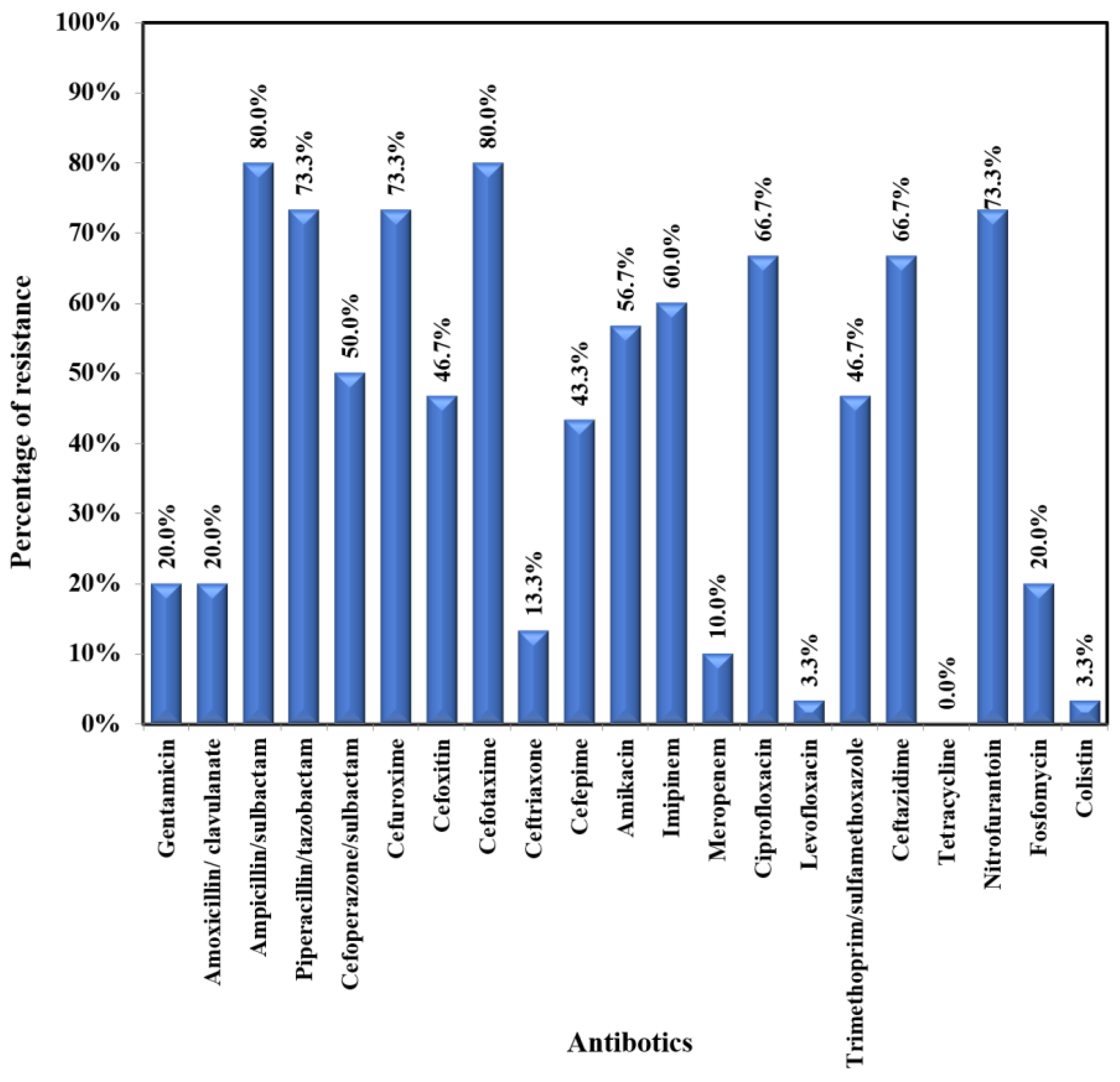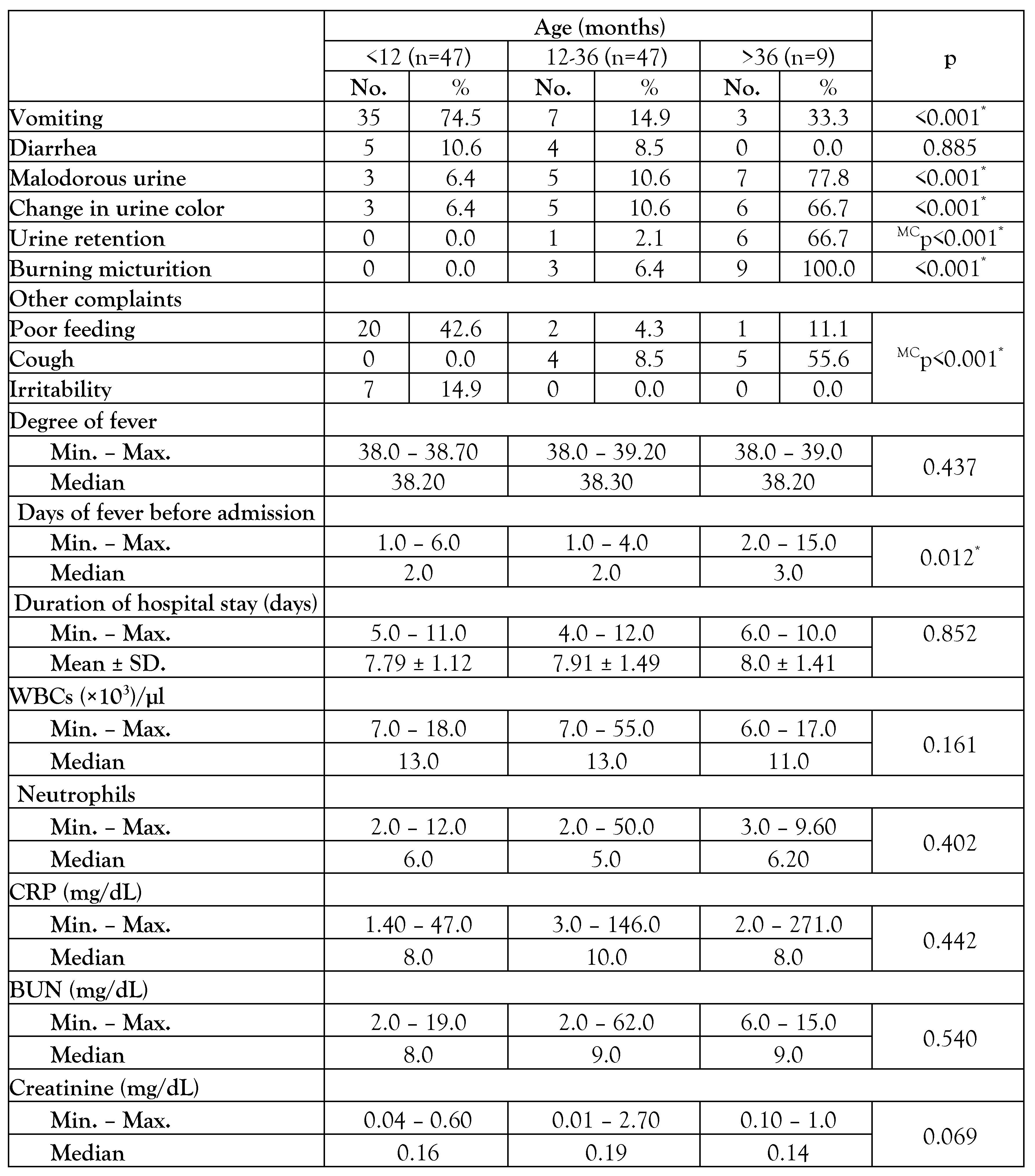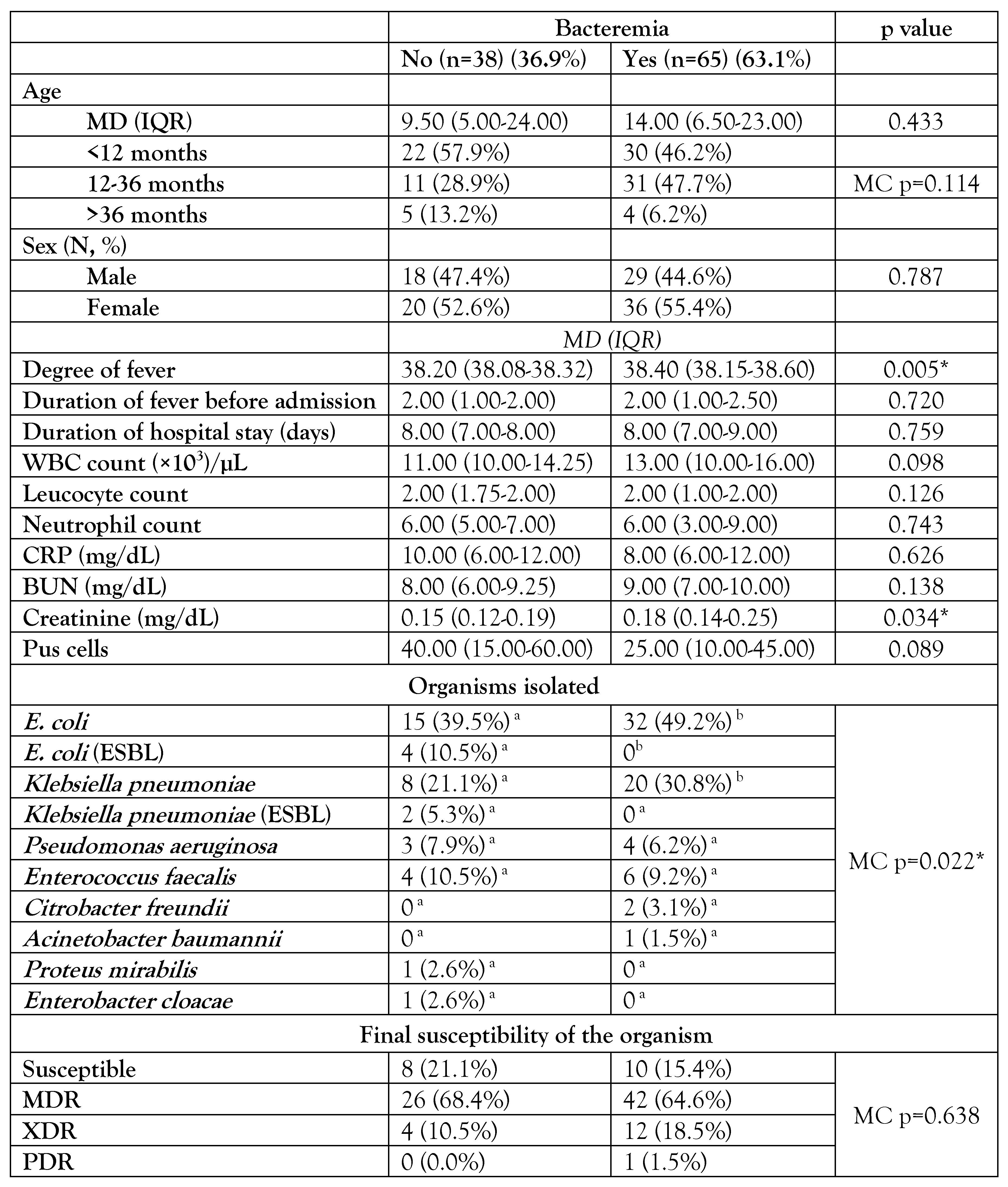Bacteremia and Antimicrobial Resistance Pattern of Uropathogens Causing Febrile Urinary Tract Infection in a Pediatric University Hospital
Abstract
Introduction
Methods
Study design
Collection of data
Microbiological investigations
Sample collection
Processing of samples
- -
- Single organism with colony count ≥105 colony forming units (CFU)/mL
- -
- Two organisms ≥105 CFU/mL for each with significant pyuria (≥10 WBC/high power field).
- -
- The growth of two isolates with ≥105 CFU/mL for one isolate and <104 CFU/mL for the other one with significant pyuria; identification was done only for the first isolate.
Statistical analysis
Results
Discussion
Conclusions
Author Contributions
Funding
Institutional Review Board Statement
Data Availability Statement
Acknowledgments
Conflicts of Interest
References
- Desai, S.; Aronson, P.L.; Shabanova, V.; et al. Parenteral antibiotic therapy duration in young infants with bacteremic urinary tract infections. Pediatrics 2019, 144, e20183844. [Google Scholar] [CrossRef] [PubMed]
- Goeller, C.; Desmarest, M.; Garraffo, A.; Bonacorsi, S.; Gaschignard, J. Management of febrile urinary tract infection with or without bacteraemia in children: A French case-control retrospective study. Front Pediatr 2020, 8, 237. [Google Scholar] [CrossRef]
- Subcommittee on Urinary Tract Infection, Steering Committee on Quality Improvement and Management; Roberts, K.B. Urinary tract infection: Clinical practice guideline for the diagnosis and management of the initial UTI in febrile infants and children 2 to 24 months. Pediatrics 2011, 128, 595–610. [Google Scholar] [CrossRef]
- Kaufman, J.; Temple-Smith, M.; Sanci, L. Urinary tract infections in children: An overview of diagnosis and management. BMJ Paediatr Open 2019, 3, e000487. [Google Scholar] [CrossRef]
- Tullus, K. Fifteen-minute consultation: Why and how do children get urinary tract infections? Arch Dis Child Educ Pract Ed 2019, 104, 244–247. [Google Scholar] [CrossRef]
- Korbel, L.; Howell, M.; Spencer, J.D. The clinical diagnosis and management of urinary tract infections in children and adolescents. Paediatr Int Child Health 2017, 37, 273–279. [Google Scholar] [CrossRef]
- Megged, O. Bacteremic vs nonbacteremic urinary tract infection in children. Am J Emerg Med 2017, 35, 36–38. [Google Scholar] [CrossRef]
- Tille, P. Bailey and Scott’s Diagnostic Microbiology, 15th ed.; Mosby Elsevier: St Louis, Missouri, 2022. [Google Scholar]
- Clinical and Laboratory Standards Institute. Performance standards for antimicrobial susceptibility testing, 31st ed.; CLSI supplement M100; CLSI: Wayne, Pennsylvania, USA, 2021. [Google Scholar]
- Magiorakos, A.P.; Srinivasan, A.; Carey, R.B.; et al. Multidrug-resistant, extensively drug-resistant, and pan drug-resistant bacteria: An international expert proposal for interim standard definitions for acquired resistance. Clin Microbiol Infect 2012, 18, 268–281. [Google Scholar] [CrossRef]
- Schnadower, D.; Kuppermann, N.; Macias, C.G.; et al. Febrile infants with urinary tract infections at very low risk for adverse events and bacteremia. Pediatrics 2010, 126, 1074–1083. [Google Scholar] [CrossRef] [PubMed]
- Lee, H.; Lee, Y.S.; Jeong, R.; Kim, Y.J.; Ahn, S. Predictive factors of bacteremia in patients with febrile urinary tract infection: An experience at a tertiary care center. Infection 2014, 42, 669–674. [Google Scholar] [CrossRef] [PubMed]
- Averbuch, D.; Nir-Paz, R.; Tenenbaum, A.; et al. Factors associated with bacteremia in young infants with urinary tract infection. Pediatr Infect Dis J 2014, 33, 571–575. [Google Scholar] [CrossRef] [PubMed]
- Yoon, S.H.; Shin, H.; Lee, K.H.; et al. Predictive factors for bacteremia in febrile infants with urinary tract infection. Sci Rep 2020, 10, 4469. [Google Scholar] [CrossRef] [PubMed]
- Ohnishi, T.; Mishima, Y.; Matsuda, N.; et al. Clinical characteristics of pediatric febrile urinary tract infection in Japan. Int J Infect Dis 2021, 104, 97–101. [Google Scholar] [CrossRef]
- Kim, D.; Lee, S.H.; Tchah, H.; Ryoo, E.; Cho, H.K.; Kim, Y.M. Association between elevated alanine aminotransferase and urosepsis in children with acute pyelonephritis. Pediatr Gastroenterol Hepatol Nutr 2016, 19, 54–60. [Google Scholar] [CrossRef]
- Hameed, T.; Al Nafeesah, A.; Chishti, S.; Al Shaalan, M.; Al Fakeeh, K. Community-acquired urinary tract infections in children: Resistance patterns of uropathogens in a tertiary care center in Saudi Arabia. Int J Pediatr Adolesc Med 2019, 6, 51–54. [Google Scholar] [CrossRef]
- Fenta, A.; Dagnew, M.; Eshetie, S.; Belachew, T. Bacterial profile, antibiotic susceptibility pattern and associated risk factors of urinary tract infection among clinically suspected children attending at Felege-Hiwot comprehensive and specialized hospital, Northwest Ethiopia. A prospective study. BMC Infect Dis 2020, 20, 673. [Google Scholar] [CrossRef]
- Demir, M.; Kazanasmaz, H. Uropathogens and antibiotic resistance in the community and hospital-induced urinary tract infected children. J Glob Antimicrob Resist 2020, 20, 68–73. [Google Scholar] [CrossRef]
- Falup-Pecurariu, O.; Leibovitz, E.; Vorovenci, C.; et al. First UTI episode in life in infants <1 year of age: Epidemiologic, clinical, microbiologic and disease recurrence characteristics. Pediatr Neonatol 2020, 61, 613–619. [Google Scholar] [CrossRef]
- Shrestha, L.B.; Baral, R.; Poudel, P.; Khanal, B. Clinical, etiological, and antimicrobial susceptibility profile of pediatric urinary tract infections in a tertiary care hospital of Nepal. BMC Pediatr 2019, 19, 36. [Google Scholar] [CrossRef]
- Parajuli, N.P.; Maharjan, P.; Parajuli, H.; et al. High rates of multidrug resistance among uropathogenic Escherichia coli in children and analyses of ESBL producers from Nepal. Antimicrob Resist Infect Control 2017, 6, 9. [Google Scholar] [CrossRef] [PubMed]
- Merga Duffa, Y.; Terfa Kitila, K.; Mamuye Gebretsadik, D.; Bitew, A. Prevalence and antimicrobial susceptibility of bacterial uropathogens isolated from pediatric patients at Yekatit 12 Hospital Medical College, Addis Ababa, Ethiopia. Int J Microbiol 2018, 2018, 8492309. [Google Scholar] [CrossRef]
- Horie, A.; Nariai, A.; Katou, F.; et al. Increased community-acquired upper urinary tract infections caused by extended-spectrum beta-lactamase-producing Escherichia coli in children and the efficacy of flomoxef and cefmetazole. Clin Exp Nephrol 2019, 23, 1306–1314. [Google Scholar] [CrossRef] [PubMed]
- Sangeda, R.Z.; Paul, F.; Mtweve, D.M. Prevalence of urinary tract infections and antibiogram of uropathogens isolated from children under five attending Bagamoyo District Hospital in Tanzania: A cross-sectional study. F1000Research 2021, 10, 449. [Google Scholar] [CrossRef]
- Gunduz, S.; Uludağ Altun, H. Antibiotic resistance patterns of urinary tract pathogens in Turkish children. Glob Health Res Policy 2018, 3, 10. [Google Scholar] [CrossRef] [PubMed]




 |
 |
© GERMS 2023.
Share and Cite
Heshmat, H.; Meheissen, M.; Farid, A.; Hamza, E. Bacteremia and Antimicrobial Resistance Pattern of Uropathogens Causing Febrile Urinary Tract Infection in a Pediatric University Hospital. GERMS 2023, 13, 210-220. https://doi.org/10.18683/germs.2023.1387
Heshmat H, Meheissen M, Farid A, Hamza E. Bacteremia and Antimicrobial Resistance Pattern of Uropathogens Causing Febrile Urinary Tract Infection in a Pediatric University Hospital. GERMS. 2023; 13(3):210-220. https://doi.org/10.18683/germs.2023.1387
Chicago/Turabian StyleHeshmat, Hassan, Marwa Meheissen, Ahmed Farid, and Eman Hamza. 2023. "Bacteremia and Antimicrobial Resistance Pattern of Uropathogens Causing Febrile Urinary Tract Infection in a Pediatric University Hospital" GERMS 13, no. 3: 210-220. https://doi.org/10.18683/germs.2023.1387
APA StyleHeshmat, H., Meheissen, M., Farid, A., & Hamza, E. (2023). Bacteremia and Antimicrobial Resistance Pattern of Uropathogens Causing Febrile Urinary Tract Infection in a Pediatric University Hospital. GERMS, 13(3), 210-220. https://doi.org/10.18683/germs.2023.1387




